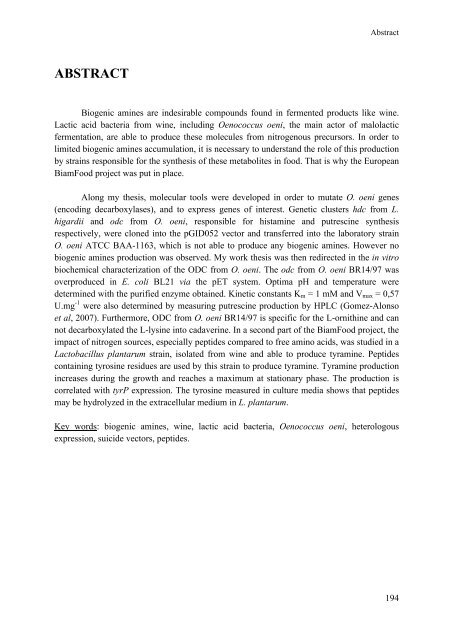THESE Maryse Bonnin Jusserand - Université de Bourgogne
THESE Maryse Bonnin Jusserand - Université de Bourgogne
THESE Maryse Bonnin Jusserand - Université de Bourgogne
Create successful ePaper yourself
Turn your PDF publications into a flip-book with our unique Google optimized e-Paper software.
ABSTRACT<br />
Abstract<br />
Biogenic amines are in<strong>de</strong>sirable compounds found in fermented products like wine.<br />
Lactic acid bacteria from wine, including Oenococcus oeni, the main actor of malolactic<br />
fermentation, are able to produce these molecules from nitrogenous precursors. In or<strong>de</strong>r to<br />
limited biogenic amines accumulation, it is necessary to un<strong>de</strong>rstand the role of this production<br />
by strains responsible for the synthesis of these metabolites in food. That is why the European<br />
BiamFood project was put in place.<br />
Along my thesis, molecular tools were <strong>de</strong>veloped in or<strong>de</strong>r to mutate O. oeni genes<br />
(encoding <strong>de</strong>carboxylases), and to express genes of interest. Genetic clusters hdc from L.<br />
higardii and odc from O. oeni, responsible for histamine and putrescine synthesis<br />
respectively, were cloned into the pGID052 vector and transferred into the laboratory strain<br />
O. oeni ATCC BAA-1163, which is not able to produce any biogenic amines. However no<br />
biogenic amines production was observed. My work thesis was then redirected in the in vitro<br />
biochemical characterization of the ODC from O. oeni. The odc from O. oeni BR14/97 was<br />
overproduced in E. coli BL21 via the pET system. Optima pH and temperature were<br />
<strong>de</strong>termined with the purified enzyme obtained. Kinetic constants Km = 1 mM and Vmax = 0,57<br />
U.mg -1 were also <strong>de</strong>termined by measuring putrescine production by HPLC (Gomez-Alonso<br />
et al, 2007). Furthermore, ODC from O. oeni BR14/97 is specific for the L-ornithine and can<br />
not <strong>de</strong>carboxylated the L-lysine into cadaverine. In a second part of the BiamFood project, the<br />
impact of nitrogen sources, especially pepti<strong>de</strong>s compared to free amino acids, was studied in a<br />
Lactobacillus plantarum strain, isolated from wine and able to produce tyramine. Pepti<strong>de</strong>s<br />
containing tyrosine residues are used by this strain to produce tyramine. Tyramine production<br />
increases during the growth and reaches a maximum at stationary phase. The production is<br />
correlated with tyrP expression. The tyrosine measured in culture media shows that pepti<strong>de</strong>s<br />
may be hydrolyzed in the extracellular medium in L. plantarum.<br />
Key words: biogenic amines, wine, lactic acid bacteria, Oenococcus oeni, heterologous<br />
expression, suici<strong>de</strong> vectors, pepti<strong>de</strong>s.<br />
194

















